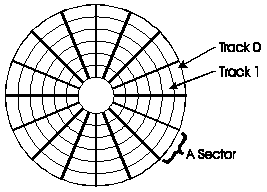| | Storage : Magnetic Disks |
|
Magnetic disks are the most common backing storage device. Data is stored using magnetised spots called domains on the disk. Each domain can store one bit of data (a 0 or a 1). A 3.5" 1.44Mb floppy disk used on a PC contains 16,777,216 such spots. A 3.5" 120Gb hard disk drive contains over 120 billion spots!
Data stored on disks is arranged along a series of concentric rings called tracks. Each track is divided up into a number of sectors. Data is read to and written from a disk one sector at a time. A sector usually contains 512 or 1024 bytes of data.

The process of dividing a disk up into tracks and sectors so it can be used on a computer is known as formatting. You must format a new disk before you can use it.
Data is read from the disk using a disk head which moves mechanically about the disk (rather like a record player tone arm). The disk head can move directly to any sector on the disk. Because of this a computer system can load a file or a record from a file very quickly. The system can move directly to the location of the record/file and read it without having to read any other data from the disk. This is known as direct access. For most applications using a direct access medium is much faster than using a serial access medium.
The two main types of magnetic disks are floppy disks and hard disks.
GCSE ICT Companion 04 - (C) P Meakin 2004